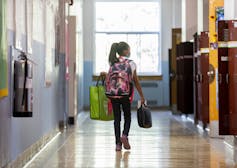
Recently there has been a resurgence of movements across North America resisting anti-racist reforms such as the use of critical race theory in schools.
These movements are often organized covertly, using social justice language and describing themselves as “anti-woke.”
Groups that oppose the teaching of critical race theory and 2SLGBTQ+ supports in schools often position themselves as truly or more accurately in favour of social justice by co-opting social justice language, alleging critical race theory discriminates against white people. School boards have been at the centre of these attacks.
As Ontario residents prepare to go to the polls in municipal elections on Oct. 24, CBC reports that “dozens of candidates are running on promises to roll back protections for transgender students, part of a concerted effort by conservative lobby groups to undo policies aimed at addressing systemic discrimination.”
Currently, school boards are bearing the brunt of backlash because their role in the public education system is the most accessible for members of the public to voice their concerns and try to have direct influence over policy and practice.
Sites of contestation
While school boards have always been sites of contestation, there has been a recent rise in hate directed at those in the system working towards social justice. This includes school board directors and teachers who have tried to enact anti-racist reforms in Ontario schools.
In Waterloo Region, the chairperson of the public district school board received death threats and hate mail after disallowing a now-retired teacher from presenting on books she felt weren’t age-appropriate that discussed asexuality and transgender identity.
In Chilliwack, B.C., a trustee received a message threatening to report her to the RCMP sex crimes unit after she argued against banning books with LGBTQ+ and anti-racist content.
This pushback against social justice work in schools is not new. Principals in Ontario have been experiencing it for years.
Political will of the public?
School trustees occupy a space between politics and administration. They represent the political will of the public but are supposed to leave the actual running of the school district to the director of education and other education professionals.
Under this dichotomy, politics and policy are the domain of the school board, whereas the director and other district staff have authority over administration. In practice, these boundaries are often blurred.
Part of what complicates matters is the governance structure of school boards. School trustees (elected school board members) are locally elected but are tasked with working “as one body representing the entire community.”
But given that they are each individually accountable to their constituents, some trustees prefer to take a hand-ons approach to addressing issues of local concern.
This complicates what might ordinarily be considered a “politics-administration dichotomy” — a divide that some researchers note is questionable and contentious.
Elected school boards in Canada
Elected school boards have a history in Canada that predates Confederation. The idea behind the creation of school boards was for civic leaders to gather and decide how best to educate the children of the local community.
Read more: Québec's Bill 40 further undermines the province's English-language school system
Historically, boards governed relatively small geographic areas and only a handful of schools. For example, in 1969, Ontario had around 3,500 school boards.
In the 1960s, proponents of larger school systems argued that amalgamation would increase the financial resources of school boards which would allow for the hiring of specialized staff and an increase in the quality of services they could provide.
From the 1960s to 1990s, Ontario went from over 3,500 school boards, to 230 county school boards, and finally down to the 72 district school boards that exist today.

Board mandates shifted
During this time, the mandate of school boards has grown considerably. For much of their history, school boards were legally responsible for hiring teachers and furnishing schools.
Today’s school boards are also responsible for promoting student achievement, well-being, equity and inclusion, preventing bullying, providing for students with special education needs, ensuring community input through school councils, scheduling busing, establishing student dress codes and co-ordinating with child-care centres, among many other things. In Ontario, all of these responsibilities are highlighted in the Ontario Education Act.
As a result of these changes, school boards have become large and complex administrative units. This makes effective governance of school boards both challenging and important.
Contentious position of board trustees
Local school boards in Ontario are responsible for much of what happens in the day-to-day operation of schools, with members of the school board receiving their positions through municipal elections, a process that is often misunderstood.
The position of the school board trustee is contentious. Almost anyone qualifies for a role and obtains great power to influence educational policy and practice, raising questions about the tension between democratic control and expert authority.
While it’s clear that school trustees play an important role in shaping the education that children receive, during election time voters often have little awareness of their trustee candidates.
According to the Canadian Anti-Hate Network, this has provided an opening for far-right groups to try to stack school boards with candidates that harbour anti-equity ideologies.
To help prevent this, the organization has come up with a framework for asking trustee candidates important questions that are centred around children’s rights.
Student well-being

While local democratic engagement is necessary, it is important that politics not be allowed to subsume school districts and distract from the core purpose of schooling — student learning and well-being.
Checks and balances are required to ensure that the focus remains on creating and sustaining a school system that all students deserve.
As our society rethinks possibilities for critical democratic engagement in schooling that attends to issues of power and identity, we invite rethinking school boards. Communities need to imagine decision-making structures that include students, community organizations, educational experts and elected officials.
Sachin Maharaj receives funding from SSHRC.
Stephanie Tuters receives funding from SSHRC.
Vidya Shah receives funding from SSHRC.
This article was originally published on The Conversation. Read the original article.







